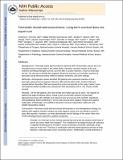| dc.contributor.author | Ferrone, Cristina Rosa | |
| dc.contributor.author | Pieretti-Vanmarcke, Rafael | |
| dc.contributor.author | Bloom, Jordan P | |
| dc.contributor.author | Hui, Hui | |
| dc.contributor.author | Szymonifka, Jackye | |
| dc.contributor.author | Wargo, Jennifer Ann | |
| dc.contributor.author | Thayer, Sarah P. | |
| dc.contributor.author | Lauwers, Gregory Y. | |
| dc.contributor.author | Deshpande, Vikram | |
| dc.contributor.author | Mino-Kenudson, Mari | |
| dc.contributor.author | Fernandez-Del Castillo, Carlos F. | |
| dc.contributor.author | Lillemoe, Keith Douglas | |
| dc.contributor.author | Warshaw, Andrew Louis | |
| dc.date.accessioned | 2014-07-29T16:40:02Z | |
| dc.date.issued | 2012 | |
| dc.identifier.citation | Ferrone, Cristina R., Rafael Pieretti-Vanmarcke, Jordan P. Bloom, Hui Zheng, Jackye Szymonifka, Jennifer A. Wargo, Sarah P. Thayer, et al. 2012. Pancreatic ductal adenocarcinoma: Long-term survival does not equal cure. Surgery 152(3): S43–S49. | en_US |
| dc.identifier.issn | 0263-9319 | en_US |
| dc.identifier.uri | http://nrs.harvard.edu/urn-3:HUL.InstRepos:12601542 | |
| dc.description.abstract | Background: Pancreatic ductal adenocarcinoma represents 90% of pancreatic cancers and is an important cause of cancer death in the United States. Operative resection remains as the only treatment providing prolonged survival, but even after a curative resection, 5-year survival rates are low. Our aim was to identify the prognostic factors for long-term survival after resection of pancreatic ductal adenocarcinoma related to patients, treatments, and tumor biology. Methods: Retrospective review identified 959 patients who underwent resection of their pancreatic adenocarcinoma between February 1985 and December 2010, of whom 499 were resected before November 2006 and represent the cohort we describe in this study. Patient, tumor, and treatment-related variables were assessed for their associations with 5- and 10-year overall survival. Results: Of the 499 patients, 49% were female and median age was 65 years. The majority of patients had stage IIb disease (60%). Actual 5-year survival after resection of pancreatic adenocarcinoma was 19% (95/499), and actual 10-year survival was 10% (33/329). Significant clinicopathologic factors predicting 5- and 10-year survival were negative margins and negative nodal status. Interestingly, 41% (39/95) of long-term survivors had positive nodes and 24% (23/95) had positive margins. Conclusion: Pancreatic ductal adenocarcinoma demonstrates a very heterogeneous biology, but patients with negative resection margins and node negative cancers are more likely to survive 5 years after resection. However, our series demonstrates that the biology of the cancer rather than simple pathologic factors determine a patient's prognosis. | en_US |
| dc.language.iso | en_US | en_US |
| dc.publisher | Elsevier BV | en_US |
| dc.relation.isversionof | doi:10.1016/j.surg.2012.05.020 | en_US |
| dash.license | LAA | |
| dc.title | Pancreatic Ductal Adenocarcinoma: Long-Term Survival Does Not Equal Cure | en_US |
| dc.type | Journal Article | en_US |
| dc.description.version | Accepted Manuscript | en_US |
| dc.relation.journal | Surgery | en_US |
| dash.depositing.author | Lauwers, Gregory Y. | |
| dc.date.available | 2014-07-29T16:40:02Z | |
| dc.identifier.doi | 10.1016/j.surg.2012.05.020 | * |
| dash.authorsordered | false | |
| dash.contributor.affiliated | Bloom, Jordan | |
| dash.contributor.affiliated | Lillemoe, Keith | |
| dash.contributor.affiliated | Zheng, Hui | |
| dash.contributor.affiliated | Warshaw, Andrew | |
| dash.contributor.affiliated | Thayer, Sarah P. | |
| dash.contributor.affiliated | Lauwers, Gregory Y. | |
| dash.contributor.affiliated | Wargo, Jennifer Ann | |
| dash.contributor.affiliated | Fernandez-Del Castillo, Carlos | |
| dash.contributor.affiliated | Ferrone, Cristina | |
| dash.contributor.affiliated | Deshpande, Vikram | |
| dash.contributor.affiliated | Mino-Kenudson, Mari | |
| dc.identifier.orcid | 0000-0003-4230-9308 | |


